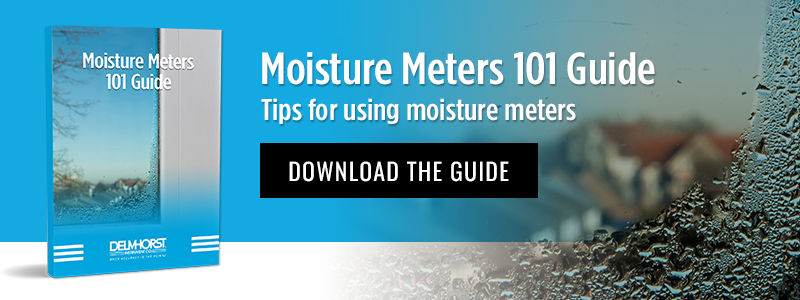Monitoring moisture is an important part of a surprising number of industries. In many of these industries, the need for an accurate, quantifiable moisture content reading of a material is so great that professionals frequently use specialized equipment for detecting and measuring moisture.
For example, farmers often use a moisture meter for agriculture, measuring moisture in cotton, hay bales, and soil. There are moisture meters for home inspectors that are used to detect excessive moisture in building materials that could indicate a risk of mold or structural damage. Restoration contractors and flooring installers frequently use floor moisture meters to monitor the moisture content of flooring materials.
Moisture meters are indispensable tools for many industries, and professionals rely on these tools to get accurate and actionable information. However, there are times when a moisture meter’s reading may not be accurate.
What causes a moisture meter to give an inaccurate reading, and how can the issue be fixed?
Here are some of the most common causes of a bad moisture reading:
#1: Using the Wrong Scale (User Error)
Moisture meters come in a wide variety of types and are usually designed to measure moisture in a specific kind of material (sometimes called the “scale” of the moisture meter). Some examples of different moisture meter scales include the hay scale, the drywall scale, and the wood scale (which is further broken up by individual wood species).
The reason for this has to do with the way the moisture meter interacts with the object being tested. With pin-type moisture meters, electrical resistance is used to measure the moisture content of a material. Because different materials might have different inherent resistances to electrical current, the meter needs to be set for the specific material being tested to give you an accurate measurement.
Pinless meters, on the other hand, use electromagnetic waves to scan materials. Here, material density is the variable that the meter needs to “know” so it can interpret the reading correctly.
Using a moisture meter that is set to a different scale than the material that you’re testing skews readings, causing inaccurate moisture meter interpretations. The best solution is to check to make sure that the meter you’re using is designed for the material you’re testing, or to make sure that it’s set to the right scale if you’re using a meter that can change between multiple scales.
#2: Low Batteries
Like any piece of electronic equipment, a moisture meter needs sufficient power to operate properly. Using a moisture meter with a low battery for a prolonged period of time can actually cause permanent damage to the meter’s electronic components, throwing off your reading results.
The best solution here is to promptly replace your meter’s battery when it starts to run low.
#3: Surface Moisture on the Material or on the Meter
If the material that you’re testing is covered in water, that surface moisture can skew your reading results for the actual %MC of the material.
With pin meters, water that is on top of the material being tested can come in direct contact with the pins, interrupting the electrical current that is used to check for moisture inside the material.
For pinless meters, surface moisture can interfere with the electromagnetic signal, skewing reading results.
There are a couple of ways to handle this. One method is to make sure that the materials you test are clear of surface moisture before testing them. Another way to deal with this is to use moisture meters with insulated pins to ensure that the readings they take are only made from the tips of the pins.
#4: The Meter is Out of Calibration
Over time and through heavy use, a moisture meter may start to fall out of calibration. This is perfectly normal. When a meter falls out of calibration, it will start to return inaccurate results that are off by just a few percentage points, which can lead to different problems depending on what the meter was being used to test.
The issue here is that it can be difficult to detect that the meter’s calibration is off in the first place.
Here, the best solution is to check the meter’s calibration before starting any major job. This can be done in a few ways, including:
-
Using a Moisture Content Standard. The Moisture Content Standard, or MCS, is a testing device for pin-type meters that should return a consistent result when used to test the meter. If you get a result other than the value set for the MCS, you know that the meter is off-calibration.
-
Using Built-in Calibration Checks. Some meters have a built-in calibration check feature that lets you do a test with the push of a button. If the check result is off, the meter is out of calibration.
-
Testing Against a Second Meter. You can compare the readings of two identical meters against each other to see if you’re getting consistent results from both. If the readings are off, then you know that at least one of the meters is off-calibration.
If you find that your meter has fallen out of calibration, check with your manufacturer to see if it can be sent in for recalibration. A simple repair may be able to restore normal function for less than it would cost to replace your meter.
These are a few of the most common reasons why a moisture meter might give you a bad reading of a material’s moisture content. If you’ve run into other causes of bad moisture readings, please share your story in the comments section below:

Comments